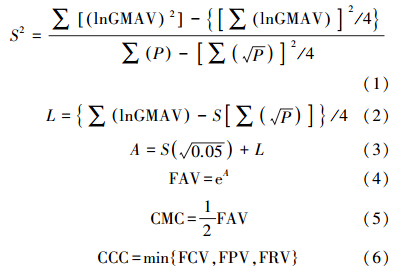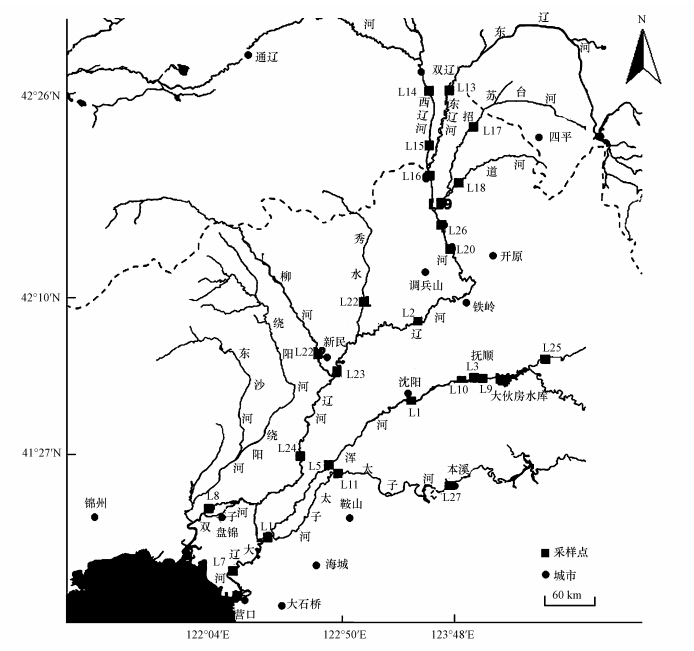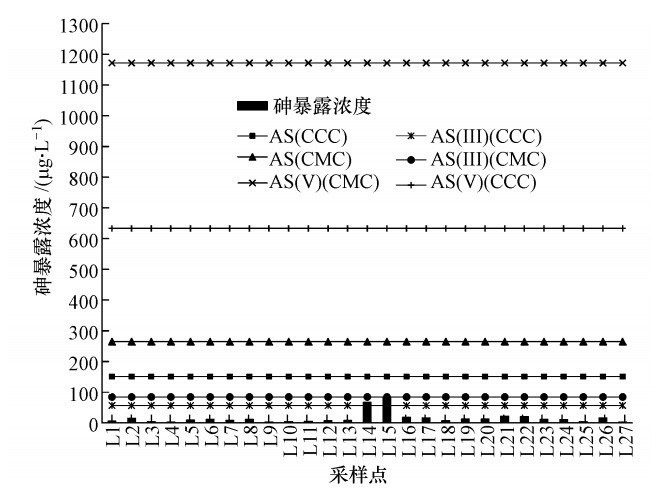砷是公认的有毒元素之一,自然界水域检出的砷浓度变化范围在0.5~5000 μg · L-1之间(Smedley et al., 2002).近年来的研究表明,矿业活动导致我国14省20多个湖泊存在严重的砷污染,砷检出浓度高达1900 μg · L-1,超出自然水域背景值104倍(金雪莲等,2012),对自然生态系统构成了严重威胁.
砷在自然界存在4种价态,-3、0、+3、+5价,其中,三价砷和五价砷在水体中比较常见,有关其毒性也研究较多.研究表明,三价砷的毒性可能是五价砷的60多倍,且无机砷的毒性比有机砷大得多(Ronald,1988),因此,关于三价砷毒性的研究也相对较为充分.美国早在20世纪80年代就制定了砷的水质基准,但当时假定无机砷和三价砷毒性相当,据此制定了砷的水生生物基准(US EPA,1980);现行的美国砷水生生物基准制定于1995年,但仍然没有区分两种价态砷的毒性(US EPA,1995).随着生态毒理学上五价砷和其他砷形态的毒性数据日渐丰富,有必要分别推算三价砷和五价砷的基准,以使其更加科学.
目前,我国水质基准研究尚处于起步阶段(Yan et al., 2013),仅初步研究并提出了若干重点污染物的水质基准阈值(Yan et al., 2012;Wang et al., 2013;闫振广等,2010;2011;2013),但尚未见基于我国水生生物分布特征的砷水生生物基准的研究报导.基于此,本文通过广泛搜集三价砷和五价砷对我国水生生物的毒性数据,使用美国国家环保总局(US EPA)推荐使用的物种敏感度排序法(SSR,Species Sensitive Rank)对我国的砷水质基准进行探讨,并基于推导的砷水质基准对辽河流域砷暴露的生态风险进行评估,以期为流域水环境管理提供支持.
2 试验材料和方法(Materials and methods) 2.1 水质基准推算分别搜集三价砷(As(III))和五价砷(As(V))对我国淡水水生生物的急、慢性毒性数据,数据来源于美国EPA的毒性数据库ECOTOX(http://cfpub.epa.gov/ecotox)和公开发表的中英文文献.数据筛选原则参见相关文献(US EPA,1985;孟伟等,2009)
2.1.1 最终急性值的计算最终急性值(FAV,Final Acute Value)的计算方法见公式(1)~(5),首先获得一个或者更多种平均急性毒性(SMAV,Speices Mean Acute Value),通过属内种平均急性毒性的几何平均值得到属平均急性毒性(GMAV,Genus Mean Acute Value).将属平均急性毒性值从高到低排列,设定级别R,最低的为1,最高的为N.如果有两个或者更多的属平均急性值相等,任意将他们排列成连续等级,计算每个属平均急性值的累积概率P=R/(N+1).选择4个累积概率接近0.05的属平均急性值,用所选择的属平均急性值和Ps(累积概率的复数形式)计算基准最大浓度(CMC,Criteria Maximum Concentration),其值为最终急性值的1/2.基准连续浓度(CCC,Criteira Continuous Concentration)为最终慢性值(FCV,Final Chornic Value)、最终植物值(FPV,Final Plant Value)和最终残留值(FRV,Final Residue Value)中的最小值.

获得最终慢性值有两种方式:一是通过与最终急性值同样的方法获得;一是通过最终急性值除以最终急性-慢性比率(FACR,Final Acute-Chornic Ratio)来获得(公式(7)).前一种要求物种满足推导急性数据的8科,数据要求量大.后一种要求至少具有3种物种的数据,分别是鱼类、无脊椎类、一种重要的敏感物种,并且急慢性比率的计算一般是同一实验条件下的数据.因此,某些情况下,可能无法计算出最终慢性值.

最终植物值(FPV)使用藻类急性毒性或水生维管束植物的毒性实验结果,所获得的最小的植物毒性值为FPV.最终残余值(FRV)的计算见公式(8).

于2013年11月在辽河及其支流浑河、太子河、秀水河、柳河、双子河区域(40°40′~42°11′ N,121°54′~123°58′ E)进行两次大范围的表层水采样调查(图 1).采样点不完全针对城区排污口,根据河流拓扑结构和空间布局进行设置,并分别采集点位上游及下游样品进行分析.本次实地调查采用PET(聚对苯二甲酸乙二醇酯)桶采水,采集了每个断面各采样点表层(3~30 cm)水体样品250 mL,混合均匀后作为该断面的实验样品.采集后样品立即封存于干净的PET瓶中,冷藏条件下运回实验室.
 |
| 图 1 辽河采样点分布示意图 Fig. 1 Sampling sites in Liao River |
量取水样(3个平行)100 mL(精确至0.001 g)于250 mL干净的玻璃烧杯中,加入1.0 mL HCl、3.0 mL HNO3,盖上浅沟型表面皿,置于电热板上95 ℃恒温加热回流至近干,将样品完全经0.45 μm滤膜过滤到干净的PET瓶中,定容至50 mL,摇匀后离心或静置2~3 h,待测.
2.2.2 质量控制所测样品均设置2个平行样,分 析时采用国标液控制工作曲线,As的回收率为 104.5%.实验所用试剂均为优级纯,实验用水均为超纯水.数据采用SPSS软件进行处理.
2.3 生态风险评估采用风险商值法(Lemly,1996; 张思锋等,2010),对辽河流域各点位的砷暴露风险进行评估,将砷暴露浓度除以获得的水水生物安全阈值,得商值(HQ,Harzard Quotient).若HQ>1,则具有风险;若HQ<1,则可以判断基本没有风险.
3 结果(Results) 3.1 五价砷的基准最大浓度和基准连续浓度 3.1.1 五价砷的基准最大浓度(CMC)五价砷化合物的水生生物急性毒性值筛选结果如表 1所示.涉及的五价砷化合物包括AsNa3O4、AsHNa2O4、As2O5、H3AsO4共4种,水生生物包含18属,23种.毒性终点为96h-LC50/EC50(溞类和摇蚊为48h-LC50/EC50).属平均急性毒性值(GMAV)是种平均急性毒性值(SMAV)的几何平均值,其变化范围在2180.17~135663 μg · L-1之间.网纹溞(Ceriodaphnia dubia)对五价砷最敏感,GMAV为2180.17 μg · L-1,昆虫类的摇蚊(Chironomus sp.)表现最不敏感,GMAV为135663 μg · L-1.鱼类10属13种的GMAV一般在104 μg · L-1 左右;摇蚊(Chironomus sp.)和底栖类的颤蚓(Tubifex tubifex)、淡水螺(Potamopyrgus antipodarum)的GMAV在105 μg · L-1左右;溞类的GMAV变化1个数量级,在103~104 μg · L-1之间.将GMAV依据数值由大到小排序等级18,累积概率P变化为0.05~0.95,选择P接近0.05的4个物种的GMAV,根据USEPA的SSR法(EPA,1985;闫振广等,2011),如公式(1)~(5)计算出FAV为2343 μg · L-1,则CMC为1171 μg · L-1.
| 表1 五价砷水生生物急性毒性值 Table 1 Acute ecotoxicity of arsenate to aquatic life |
筛选五价砷的慢性毒性数据,满足条件的有黑头软口鲦(Pimephales promelas)和虹鳟(Oncorhynchus mykiss)两种鱼类(表 2).计算最终急慢性比率(FACR),并通过公式(7)计算最终慢性值(FCV).黑头软口鲦慢性毒性暴露30 d,取无效应浓度(NOEC,No Observed Adverse Effects Concentration)和最小效应浓度(LOEC,Lowest Observed Effects Concentration)的几何平均值(891.63 μg · L-1)作为慢性毒性数据,根据表 1中黑头软口鲦对As2O5的急性毒性数据求得FACR为5.98;同理,求得虹鳟的FACR为2.29(表 2),取两种鱼类FACR的几何平均值作为五价砷对筛选所有生物的FACR值(3.70).根据公式(7)得到五价砷的水生生物FCV为633.3 μg · L-1;比较满江红(Azolla pinnata)28 d-LOEC1000 μg · L-1,取较小值羊角月牙藻(Pseudokirchneriella subcapitata)的96h-EC50 690 μg · L-1作为最终植物值(FPV)(表 3);砷的生物富集性很低,不考虑砷的生物残留值(FRV),比较FCV和FPV,取最小值FCV为633.3 μg · L-1作为基准连续浓度(CCC),即五价砷的急性基准值为1171 μg · L-1,慢性基准值为633.3 μg · L-1.
| 表2 砷化合物的急慢性比率 Table 2 FACR of arsenic compounds |
| 表3 砷对水生植物的毒性 Table 3 The toxicity of arsenic on aquatic plants |
表 4中列出了筛选的三价砷对水生生物的急性毒性值,三价砷化合物除As2S3外,其余均为As2O3,水生生物包含了“三门八科”的12个属,12种.属平均急性毒性值(GMAV)变化范围在249~82300 μg · L-1 之间;两栖类表现最敏感,六趾蛙(Euphlyctis hexadactylus)的GMAV为249 μg · L-1;黑头软口鲦表现最不敏感,96h-LC50为82300 μg · L-1;其次是溞类,大型溞(Daphnia magna)GMAV 的48h-EC50为5200 μg · L-1,占多数的鱼类和底栖类GMAV数量级在105 μg · L-1左右.同样根据与五价砷相似的方式求得FAV为168.53 μg · L-1,则CMC为84.26 μg · L-1.
| 表4 三价砷水生生物急性毒性 Table 4 Acute ecotoxicity of arsenite to aquatic life |
符合慢性毒性数据筛选原则的生物只有大型溞.大型溞48 h急性数据和21 d慢性数据的比值为1.53(表 2),计算其与FACR 5.8(表 2)的几何平均值作为三价砷最终FACR,则FCV为56.55 μg · L-1; 三价砷生物累积系数(BCF)不高,因此,同样不用考虑体内残留值的影响.得出三价砷的急性基准值为84.26 μg · L-1,慢性基准值为56.55 μg · L-1.
3.3 总砷的基准最大浓度和基准连续浓度表 5是总砷水生生物的急性毒性值筛选数据表.总砷包括AsNa3O4、AsNa3O4、As2O3、As2O5等4种砷化合物,包括+3和+5价,水生生物包含25属,29种.GMAV变化范围在249.0~135663.0 μg · L-1之间;两栖类六趾蛙(Euphlyctis hexadactylus)表现最敏感,96h-LC50 为249.0 μg · L-1,昆虫类摇蚊属(Chironomus sp.)表现最不敏感,48h-LC50 为135663.0 μg · L-1;其他如溞属的网纹溞(Ceriodaphnia dubia)和大型溞(Daphnia magna)GMAV 均为104 μg · L-1.占19种16属的鱼类GMAV变化范围在104~105 μg · L-1之间,其中,北极茴鱼(Thymallus arcticus)是鱼类中最敏感的,96h-LC50 为5084.22 μg · L-1;玛丽鱼(Poecilia latipinna)是鱼类中最不敏感的,96h-LC50为64000.0 μg · L-1;甲壳类只有1种龙纹虾(Procambarus sp.),其96h-LC50为51000 μg · L-1;软体类淡水螺(Potamopyrgus antipodarum)的96h-LC50为9507.0 μg · L-1.根据公式(1)~(6)计算得到,总砷对水生生物的最终急性值(FAV)为528.8 μg · L-1,则急性基准浓度(CMC)为264.4 μg · L-1.FACR为3.51(表 2中所有FACR的几何平均值),FCV为150.7 μg · L-1,FPV为690 μg · L-1(表 3),总砷急性基准值为264.4 μg · L-1,慢性基准值为150.7 μg · L-1.
| 表5 总砷水生生物急性毒性 Table 5 Acute Ecotoxicity of the total arsenic to aquatic life |
图 2为辽河流域枯水期砷暴露的浓度及各形态砷的风险阈值.由图可知,三价砷的急慢性基准最低,总砷次之,五价砷最高,砷的基准阈值范围都没有交叉.辽河砷暴露范围在2.6~82.14 μg · L-1之间,平均浓度为14.90 μg · L-1.整体而言,辽河流域有两个位点(L14、L15)风险最高,砷浓度分别达到67.65 μg · L-1和82.14 μg · L-1,比三价砷慢性基准范围分别高1.20和1.45倍,在地理位置上属于西辽河段上游(图 1).其余点位均低于三价砷基准风险阈值,即低于所有砷风险阈值.
 |
| 图 2 辽河流域砷分布及其风险阈值 Fig. 2 Exposed arsenic concentrations and arsenic risk limits in Liao River |
选择哪一种形态作为水生物保护的界限,才不致对水生生物造成“过保护”或“欠保护”需要考虑.参照美国EPA最新颁布的关于砷的基准文件,砷慢性基准值为150 μg · L-1,急性基准值为340 μg · L-1(US EPA,1995),本文的总砷慢性基准值为150.7 μg · L-1,急性基准值为264.4 μg · L-1.与之相比,总砷的慢性基准值与美国基准相当,急性基准值比美国基准略小,总体基准范围比美国基准略窄.美国对于砷基准推导主要采用三价砷的数据(US EPA,1995),由于研究开展时间较早(20世纪80年代),当时的五价砷毒性数据不完备,无法判定五价砷和三价砷毒性大小,故假设五价砷与三价砷具有同样的毒性,主要利用三价砷的毒性数据推导出砷的水生生物基准.目前,美国现行的砷基准制定于1995年,依然没有区分毒性相差很大的三价砷和五价砷毒性数据(US EPA,1995).本文研究表明,三价砷的急性基准值为56.55 μg · L-1,慢性基准值为84.26 μg · L-1;而五价砷的急性基准值为1171 μg · L-1,慢性基准值为633.3 μg · L-1;五价砷的急性基准值比三价砷高出约14倍,慢性基准值高出约11倍,基准范围高出10倍.因此,需要分别制定三价砷和五价砷基准.
在物种毒性数据搜集上,ECOTOX数据库有很多毒性数据,而国内研究很少.涉及的砷化合物有砷的+5、+3、0、-3价态,无机态和有机态物质主要包括:砷酸钠盐、砷酸、亚砷酸盐、砷单质、砷金属化合物、甲基砷(MMA,Methylarsenic acid)和二甲基砷(DMA,Di-methylarsenic acid)等.前人对砷的毒性基本形成共识:即无机砷毒性比有机砷大很多,无机砷中三价砷比五价砷毒性大(Ronald,1988;US EPA,2013; Cockell et al., 1988;Hughes et al., 2011).在实际的数据筛选过程中,有机砷、单质砷及砷金属化合物的毒性数据被舍弃.砷酸盐和亚砷酸盐在河流等水域检出频率高,所占比例基本达到85%以上(田中茂等,1988),这有利于如实反映自然流域的生态风险;单质砷在自然界中不单独存在,也不易溶解,无毒,尽管有些溞类对它的敏感性比砷化合物略低(Mount et al., 1984).砷金属化合物的毒性一般比砷的钠盐化合物大得多(Mayer et al., 1986),可能是因为砷与金属化合物一般具有联合毒性.
数据筛选中急性毒性采用96h-LC50(对溞类和蚊类采用48h-LC50),慢性毒性一般采用28 d以上的数据(溞类和蚊类采用21 d以上数据).对于同一物种,慢性毒性数据达到28 d以上的优先选择敏感度比较高的胚胎或幼虫,其次选择最长的天数以涵盖全生命周期,同一份研究中选用比较敏感的数据,被引入到中国人工养殖或观赏用的外来物种数据均被采用.筛选的数据中鲤科类研究较少,后续研究中可以增加中国本土物种,如鲤科鱼类的毒性数据(闫振广等,2009),因为鲤科类在中国水系的比例很高;也可以考虑针对我国水系特点的“三门六科”,即鲤科、除鲤科类外的另一种冷水鱼、两栖类、浮游甲壳类、昆虫类和环节动物类的毒性数据筛选(刘征涛等,2012);或为了保护重要水生物种,减少实验量,采用种间相关性评估(ICE,Interspecies Correlation Estimation)模型,通过输入3种模式生物(鱼类、溞类、藻类的毒性数据,得出一系列物种的毒性数据,通过实验验证其合理性并得出基准(Dyer et al., 2006);同时,需要考察水质因素的影响,如水温、pH、Eh、硬度、溶解氧,Eh、pH、溶解氧主要决定三价砷和五价砷的存在比例,目前有研究表明低水温提高了水生生物的耐受性,而硬度对砷的毒性没有影响(US EPA,1980).
筛选的慢性毒性数据比较少,计算FACR一般要求至少3种生物(脊椎、无脊椎和一种敏感物种)的慢性毒性数据(US EPA,1985),但严格按照以上原则无法计算出FACR.参照 USEPA砷基准文件中获得最终慢性值时可采用单一物种的急慢性比率作为FACR(US EPA,1980),急慢性毒性数据获得最好在同一实验条件下,或者不同实验室的相同稀释水做的急性实验结果(US EPA,1985).FACR数值一般大于1,某些物质的急慢性比率对所有物种差别不大,对于差别大的物种,选择种平均急性值接近最终急性值的FACR几何平均值(US EPA,1985).表 2中黑头软口鲦和虹鳟的急慢性比率(FACR)差别不大,取几何平均值.计算三价砷的FACR时,筛选大型溞计算FACR,本文三价砷的FACR取为1.53(表 2).对于FACR数据小于2的情况,一般是物种在慢性实验中发生了适应现象(US EPA,1985).处理总砷的FACR也采用了类似原则.
羊角月牙藻(Pseudokirchneriella subcapitata)是美国EPA、经济合作组织(OECD,Organization for Economic Co-operation and Development)和国家化标准组织(ISO,International St and ards Organization)推荐的对大部分化学物质敏感的物种,常用于检测污染物对水生生物的毒性水平,其96h-EC50为690 μg · L-1(表 3).三价砷对羊角月牙藻没有合适的植物慢性值数据,尽管其他藻类,如Scenedesmus acutus var. acutus对砷非常敏感,毒性值为159.3 μg · L-1(Chen et al., 1994),但由于为非本土种生物而舍弃.FRV是最终残留值,反映的是砷残留带来的水生生物食用风险,通常在生物富集因子(BCF)非常高的情况下考虑.通过筛选的数据表明,无论哪一种砷的生物富集系数都很低,因此,可以不考虑FRV的影响(US EPA,1980).
图 2是2013年11月份枯水期在辽河流域进行两次采样的结果,西辽河段有点位超出了三价砷CCC基准阈值,但由于采样时测定的是总砷,没有区分三价砷和五价砷的形态,因此,并不表明风险一定存在.采用商值风险评估在管理初期可以应用,通过划定标准线来判定风险大小,属于半定量生态风险评价方法,有一定的局限性.同时,当风险表征结果为无风险时,并非表明没有污染发生,而表示污染尚处于可以接受的程度(张思锋等,2010).另外,严格来讲,评价一个地区有没有风险,要求目标物质4 d的平均浓度超过CCC的频率不多于平均每3年1次,并且1 h平均浓度超过CMC的频率不多于平均每3年1次,那么区域的水生生物及其用途不会受到不可接受的风险(US EPA,1985;孟伟等,2009).因此,需要在丰水期增加采样频率和区分样品中砷形态来综合判断.
5 结论(Conclusions)本研究研究得出三价砷的急、慢性水生生物基准分别为84.24和56.55 μg · L-1,五价砷的急、慢性水生生物基准分别为1171和633.3 μg · L-1,总砷的急、慢性水生生物基准分别为264.4和150.7 μg · L-1.三价砷和五价砷毒性基准范围差别约10倍,因此,应分别考虑制定三价砷和五价砷的基准.基于三价砷的水质基准阈值对辽河流域砷暴露的风险评估表明,西辽河段上游段可能存在一定的潜在生态风险.
| [1] | Abdelghani A A, Anderson A C, McDonell D B. 1980.Toxicity of three arsenical compounds[J].Cancer Research, 13(7): 31-32 |
| [2] | Abdelghani A A,Pramar Y V,Mandal T K,et al.1995.Levels and toxicities of selected inorganic and organic contaminants in a swamp environment[J].Journal of Environmental Science and Health (Part B: Pesticides,Food Contaminants,and Agricultural Wastes),30(5): 717-731 |
| [3] | Beleau M H,Bartosz J A.1982.Colorado River Fisheries Project Acute Toxicity of Selected Chemicals: Data Base.Report No.6. Moscow:University of Idaho.243-254 |
| [4] | Buhl K J,Hamilton S J.1990.Comparative toxicity of inorganic contaminants released by placer mining to early life stages of salmonids[J].Ecotoxicology and Environmental Safety,20(3): 325-342 |
| [5] | Buhl K J.2002.The relative toxicity of inorganic contaminants to the rio grande silvery minnow (Hybognathus amarus ) and fathead minnow (Pimephales promelas ) in a water quality simulating that in the Rio Grande,New Mexico.Final Report to the U.S.Fish and Wildlife Service,Study No.2F33-9620003.Yankton: U.S. Geological Survey, Columbia Environmental Research Center, Yankton Field Research Station.75 |
| [6] | Chen F H,Chen W Q,Dai S G.1994.Toxicities of four arsenic species to scenedesmus obliguus and influence of phosphate on inorganic arsenic toxicities[J].Toxicological & Environmental Chemistry,41(1/2): 1-7 |
| [7] | Cockell K A,Hilton J W,Bettger W J.1991.Chronic toxicity of dietary disodium arsenate heptahydrate to juvenile rainbow trout (Oncorhynchus mykiss )[J].Archives of Environmental Contamination and Toxicology,21(4): 518-527 |
| [8] | Curtis M W,Copeland T L,Ward C H.1979.Acute toxicity of 12 industrial chemicals to freshwater and saltwater organisms[J].Water Research,13(2): 137-141 |
| [9] | De Foe D L.1982.Arsenic (V) Test Results[Z]. Memo to R.L.Spehar, U.S. Environmental Protection Agency.Duluth, via Ecotox |
| [10] | Dyer S D,Versteeg D J,Belanger S E,et al.2006.Interspecies correlation estimates predict protective environmental concentrations[J].Environmental Science & Technology,40(9): 3102-3111 |
| [11] | Enserink E L,Maas-Diepeveen J L,Van Leeuwen C J.1991.Combined effects of metals: an ecotoxicological evaluation[J].Water Research,25(6): 679-687 |
| [12] | Fargasova A.1994.Toxicity of metals on Daphnia magna and Tubifex tubifex [J].Ecotoxicology and Environmental Safety,27(2): 210-213 |
| [13] | Ghosh A R,Chakrabarti P.1990.Toxicity of arsenic and cadmium to a freshwater fish Notopterus notopterus [J].Environment and Ecology,8(2): 576-579 |
| [14] | Golding L A,Timperley M H,Evans C W.1997.Non-lethal responses of the freshwater snail Potamopyrgus antipodarum to dissolved arsenic[J].Environmental Monitoring and Assessment,47(3): 239-254 |
| [15] | Gupta A K,Chakrabarti P.1993.Toxicity of arsenic to freshwater fishes Mystus vittatus (Bloch) and Puntius javanicus (Blkr)[J].Environment and Ecology,11(4): 808-811 |
| [16] | Hamilton S J,Buhl K J.1990.Safety assessment of selected inorganic elements to fry of chinook salmon (Oncorhynchus tshawytscha )[J].Ecotoxicology and Environmental Safety,20(3): 307-324 |
| [17] | Hamilton S J,Buhl K J.1997.Hazard evaluation of inorganics,singly and in mixtures,to flannelmouth sucker Catostomus latipinnis in the San Juan River,New Mexico[J].Ecotoxicology and Environmental Safety,38(3): 296-308 |
| [18] | Hockett J R,Mount D R.1996.Use of metal chelating agents to differentiate among sources of acute aquatic toxicity[J].Environmental Toxicology and Chemistry,15(10): 1687-1693 |
| [19] | Hughes M F,Beck B D,Chen Y,et al.2011.Arsenic exposure and toxicology: a historical perspective[J].Toxicological Sciences,123(2): 305-332 |
| [20] | Hwang P P,Tsai Y N.1993.Effects of arsenic on osmoregulation in the tilapia Oreochromis mossambicus reared in seawater[J].Marine Biology,117(4): 551-558 |
| [21] | Jeyasingham K,Ling N.2000.Acute toxicity of arsenic to three species of New Zealand chironomids: Chironomus zealandicus ,Chironomus sp.a and Polypedilum pavidus (Diptera,Chironomidae)[J].Bulletin of Environmental Contamination & Toxicology,64(5): 708-715 |
| [22] | 金雪莲,任婧,夏峰.2012.我国河流湖泊砷污染研究进展 [J].环境科学导刊,31(5): 26-31 |
| [23] | Khangarot B S,Sehgal A,Bhasin M K.1985."Man and Biosphere" studies on the sikkim himalayas.Part 5: acute toxicity of selected heavy metals on the tadpoles of Rana hexadactyla [J].Acta Hydrochimica Et Hydrobiologica,13(2): 259-263 |
| [24] | Klauda R J.1986.Acute and chronic effects of waterborne arsenic and selenium on the early life stages of striped bass (Morone saxatilis ).Report PPRP-98.Laurel,MD: John Hopkins University.209 |
| [25] | Lemly A D.1996.Evaluation of the hazard quotient method for risk assessment of selenium[J].Ecotoxicology and Environmental Safety,35(2): 156-162 |
| [26] | 刘征涛,王晓南,闫振广,等.2012."三门六科"水质基准最少毒性数据需求原则[J].环境科学研究,25(12): 1364-1369 |
| [27] | Mayer F L Jr,Ellersieck M R.1986.Manual of Acute Toxicity: Interpretation and Data Base for 410 Chemicals and 66 Species of Freshwater Animals[M]. Washington D. C: Fish and Wildlife Service U.S. Department of Interior.505 |
| [28] | 孟伟,闫振广,刘征涛.2009.美国水质基准技术分析与我国相关基准的构建[J].环境科学,22(7): 758-761 |
| [29] | Mount D I,Norberg T J.1984.A seven-day life cycle cladoceran toxicity test[J].Environmental Toxicology and Chemistry,3(3): 425-434 |
| [30] | Pandey K,Shukla J P.1982.Deleterious effects of arsenic on the growth of fingerlings of a freshwater fish,Colisa fasciatus (Bl.& Sch.)[J].Acta Pharmacologica et Toxicologica,50(5): 398-400 |
| [31] | Passino D R M,Kramer J M.1980.Toxicity of arsenic and PCBs to fry of deepwater ciscoes (Coregonus )[J].Bulletin of Environmental Contamination and Toxicology,24(1): 527-534 |
| [32] | Passino D R M,Novak A J.1984.Toxicity of arsenate and DDT to the cladoceran Bosmina longirostris [J].Bulletin of Environmental Contamination and Toxicology,33(1): 325-329 |
| [33] | Qureshi A A,Flood K W,Thompson S R,et al.1982.Comparison of a luminescent bacterial test with other bioassays for determining toxicity of pure compounds and complex effluents// Pearson J G,Foster R B,Bishop W E.Aquatic Toxicology and Hazard Assessment 5th Conference.Philadelphia,PA: 179-195 |
| [34] | Rankin M G,Dixon D G.1994.Acute and chronic toxicity of waterborne arsenite to rainbow trout (Oncorhynchus mykiss )[J].Canadian Journal of Fisheries and Aquatic Sciences,51(2): 372-380 |
| [35] | Richter J E.1982.Results of Algal Toxicity Tests with Priority Pollutants[Z]. Memorandum to C.E. Stephan, U.S. Environmental Protection Agency.Duluth, USA: Center for Lake Superior Environmental Studies, University of Wisconsin-Superior.12 |
| [36] | Ronald E.1988.Arsenic Hazards to Fish,Wildlife,and Invertebrates: A Synoptic Review[M].Laurel, USA: Fish and Wildlife Service, U.S. Department of Interior. 92 |
| [37] | Sarkar A,Jana S.1987.Effects of combinations of heavy metals on hill activity of Azolla pinnata [J].Water,Air,and Soil Pollution,35(1/2): 141-145 |
| [38] | Schaefer E D,Pipes W O.1973.Temperature and the toxicity of chromate and arsenate to the rotifer,Philodina roseola [J].Water Research,7(12): 1781-1790 |
| [39] | Shukla J P,Shukla K N,Dwivedi U N.1987.Survivality and impaired growth in arsenic treated fingerlings of Channa punctatus ,a fresh water murrel[J].Acta Hydrochimica et Hydrobiologica,15(3): 307-311 |
| [40] | Smedley P L,Kinniburgh D G.2002.A review of the source,behaviour and distribution of arsenic in natural waters[J].Applied Geochemistry,17(5): 517-568 |
| [41] | 田中茂,孙德祥.1988.天然水中砷化合物的形态及其含量分布[J].地理科学进展,7(3): 61-66 |
| [42] | US EPA.2013. Pesticide Ecotoxicity Database (Formerly: Environmental Effects Database (EEDB)). Washington D.C, USA: Office of Pesticide Programs, Environmental Fate and Effects Division, U.S. Environmental Protection Agency. |
| [43] | US EPA.1980. Ambient Water Quality Criteria for Arsenic. Report No. EPA 440/5-80-021.Washington D.C, USA: Office of Water Regulations and Standards Criteria and Standards Division |
| [44] | US EPA. 1985. Guidelines for Deriving Numerical National Water Wuality Criteria for the Protection of Aquatic Organisms and Their Uses[M].Duluth,Minnesota;Narragansett,Rhode Island;Corvallis,Oregon,USA:Office of Research and Development, Environmental Research Laboratories, U.S. Environmental Protection Agency |
| [45] | US EPA. 1995. Water Quality Criteria Documents for the Protection of Aquatic Life in Ambient Water: 1995 Updates. Report No. EPA-820-B-96-001.Washington D.C, USA: Office of Water 4301, U.S. Environmental Protection Agency |
| [46] | Wang X N,Liu Z T,Yan Z G,et al.2013.Development of aquatic life criteria for triclosan and comparison of the sensitivity between native and non-native species[J].Journal of Hazardous Materials,260: 1017-1022 |
| [47] | Yan Z G,Zhang Z S,Wang H,et al.2012.Development of aquatic life criteria for nitrobenzene in China[J].Environmental Pollution,162: 86-90 |
| [48] | Yan Z G,Wang H,Wang Y Z,et al .2013.Developing a national water quality criteria system in China[J].Water Policy,15(6): 936-942 |
| [49] | 张思锋,刘晗梦.2010.生态风险评价方法述评[J].生态学报,30(10): 2735-2744 |
| [50] | 闫振广,孟伟,刘征涛,等.2010.我国典型流域镉水质基准研究[J].环境科学研究,23(10): 1221-1228 |
| [51] | 闫振广,孟伟,刘征涛,等.2011.我国淡水生物氨氮基准研究[J].环境科学,32(6): 1564-1570 |
| [52] | 闫振广,刘征涛,孟伟.2013.辽河流域六价铬和无机汞应急水质标准研究[J].中国工程科学,15(3): 26-32 |
 2015, Vol. 35
2015, Vol. 35


